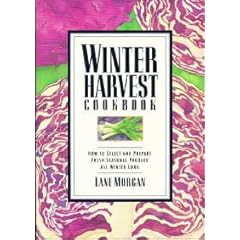
Update: Look to the right to see that Winter Harvest, substantially revised, was published in a new edition in Fall 2010.
My first cookbook, published in 1990, was Winter Harvest. It was inspired by the winter gardening charisma of my friend and neighbor, Binda Colebrook, and focused on Northwest cool-season produce that could be grown at home or bought from local suppliers.
Looking back through it recently, I was pleased to realize how many of the vegetables and techniques I wrote about then--and which some reviewers at the time found a bit weird for general consumption--are familiar fare now. When I would show up at the counter with fennel or radicchio back then, often as not the checker would have to ask me what I was buying. Now the conversations tend more to what I plan to do them. Extended farmers market seasons and CSAs also mean that it's easier to find these treats grown locally.
I wrote my rationale for winter produce before global warming, carbon footprints, and genetically engineered food were scary catchphrases, at least at my house. My focus tended toward good taste, good nutrition, and sustainable growing practices.
Now I'm curious whether others think that the ideas expressed in this part of the introduction hold up:
Why Winter Vegetables
Everything tastes best in its season. Whether your produce is from your garden or from the market, the best value for your money, your palate, and your health is in the crops that flourish most naturally. In summer, this is easy advice to follow. Who wouldn't choose fresh raspberries over stored apples in July? In winter, what used to be an inescapable cycle of seasonal food has begun to seem an exercise in self-discipline. It's hard not to be seduced by the ever-increasing array of produce from someone else's summer. But locally grown Brussels sprouts, properly cooked, really will taste better than corn trucked in from Florida.
Furthermore, the more local our food, the better we can assess its real costs and benefits. For example, nearly half the tomatoes sold in the United States between December and May come from the Culiacan Valley in Mexico. Americans want their produce spotless--especially when they are paying top dollar--so the tomatoes (and the workers who harvest them) are repeatedly and heavily sprayed with pesticides and fungicides. Then the tomatoes are picked green, bathed in chlorine, gassed with ethyline to stimulate reddening (but not ripening), and shipped across the continent, losing vitamins every step of the way.
When these tomatoes end up on the shelf in Seattle, they are still legally fresh, but they are neither tasty nor nutritious, and they may not even be safe. Assuming that they actually have been tested for violations of pesticide regulations--and that's not a safe assumption--they will have gone into the salad long before the lab reports are in. If the price tag on those tomatoes included the real costs in health and environmental damage, the product would be a lot less alluring. (Long-distance organic produce, though preferable, is not likely to rate much better nutritionally.)
Fortunately, there is no need to put purity before pleasure at the dinner table. When it comes to winter produce, good sense and good taste go together.
To support the claim about Brussels sprouts, here's a recipe from the book.
Brussels Sprout Salad
This salad needs small, sweet Brussels sprouts. Gardeners have an immense advantage here, for although Brussels sprouts keep fairly well, they hold their peak of flavor only briefly.
Ingredients
3 tablespoons fresh lemon juice, divided
1 1/2 cups sliced Jerusalem artichoke
*1 large celeriac, peeled and sliced into bite-sized pieces (discard any corky center section)
4 small leeks, white part only, chopped
1 pound fresh Brussels sprouts
3 tablespoons olive oil
1 tablespoon fresh lemon rind (optional)
salt and pepper
2 tablespoons chopped parsley
* If you want to use the more easily available--and cheaper--celery instead of celeriac, go for the more blanched parts at the base. One point of celeriac is that it has a less assertively "green" taste than celery stalks.Instructions
Combine 1 tablespoon of lemon juice and 3 cups of water in a medium bowl. Add Jerusalem artichokes and celeriac slices and let stand, covered, in the refrigerator until it's time to dress the salad.
Cook leeks in an inch of boiling salted water until tender but not slimy, about 5 minutes. Less cooked is way better than overcooked. Drain, saving the water. Bring water back to a boil and steam sprouts until crisp-tender, about 8 to 10 minutes. Dress with olive oil, the remaining 2 tablespoons of lemon juice, and lemon rind (if used). Add salt and pepper to taste, mix, and check for seasoning.
Cover and refrigerate for an hour before serving. Garnish with chopped parsley.
Serves 4.
Winter Harvest is out of print, but it's usually available used in local bookstores (Hendersons in Bellingham has a terrific cookbook section) and online.
No comments:
Post a Comment